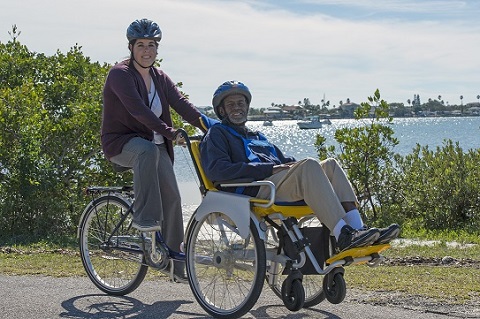Rehabilitation and Prosthetic Services
A History of Recreation Therapy in the VA
"Way back when...."
Napoleon said that in an army marches on its stomach. That was in 1812. In 1918, the American army marches on its stomach. That was in 1812. In 1918, this American army recognized the fact that even well-fed soldiers may refuse to march if their morale is low. It created the Morale Branch of the War Department.
As one sergeant defined it, "Morale is what makes your feet do what your head knows just ain't possible."
The Morale Branch had only a research function then. But it laid the groundwork for what during World War II became Special Services and acquired a status equal to other services of the Army.
Special Services provided recreation, entertainment, athletics, libraries, religious services, canteens, and coordinated volunteer services.
Recreation was established as a section with Veterans Administration, under the Rehabilitation Medicine Service Office. The complexity and interdependence of each patient's physiological, psychological and social needs were recognized and therapeutic recreation developed into a specialized, professional field.
Later, Recreation was expanded to become a separate service within VA, and the old image of diversionary "fun and games" changed to one of therapy.

Why Recreation Therapy?
"We in the medical profession have done these people no service if we offer them nothing more than potassium iodide, digitalis, and a rocking chair.' Dr. Howard Rusk, medical rehabilitation authority, said this many years ago speaking of paraplegic Veterans.
The healing process, which is the heart of the VA mission, goes far beyond medical technology. "Rehabilitate" means to "re-able," to make able again. Rehabilitation involves restoration in all areas- physical, mental, social and emotional.
It is a simple fact that a recreational program designed around the patient's needs and interests reduces the need for medication and shortens the hospital stay. Recreation addresses medical and human needs. It means much more than having a set of activity skills for spare time use. It encompasses values and attitudes.
As the availability and importance of leisure increases in today's lifestyle, so does o its potential for waste and boredom. Hospital patients often have an abundance of leisure time to deal with. In and itself, leisure is neither good nor bad. A person's use of it makes that determination.
VA patient is first a human being and secondly ill or disabled.
The Veterans Administration is the "founder" and number one user of the recreation therapy occupation in the federal system. It has played a major role in the University degree programs.
The Veterans Administration is the largest rehabilitation program under one administration in the western hemisphere.
The VA is the federal government’s largest independent agency. It operates 172 medical centers utilizing a multi-billion dollar budget to serve 30 million Veterans and their dependents.
The capacity to enjoy life and to maintain self esteem is vital to the well being of an individual particularly when recovery or adjustment is involved. Based on a core knowledge of human behavior and physiology, the goal of recreation is to creatively develop an individual's potential for self-sufficiency and enrichment.
The Recreation Therapy Program is a Leisure Delivery Service to the Veteran patient population in:
- Cardiac Rehabilitation
- Chronic Illness
- Drug and Alcohol Abuse
- Geriatrics
- Psychiatrics
- Spinal Cord Injuries
-
General Medical and Surgical
For Acute and Long Term Care Patients In
- Individual Groups
- Hospital and Community Life
The program offers games, sports, arts and crafts, music therapy, dance therapy, psycho- drama, outdoor recreation, newspaper poetry, social activities, special events, leisure counseling and community re-entry.
Rehabilitation - functions as a member of the medical team, has knowledge of the illness and problems of the physically, mentally, emotionally, and developmentally disabled and the geriatric patient.
Education - provides education and counseling in coping with leisure time, particularly with regard to a patient returning to life in the community. Creates-designs a specialized recreational program.
Research - interviews patients to learn their backgrounds, interests, and skills; identifies problems and needs.
Evaluation - analyzes the success of a program for each individual patient.
Activates - implements the program of action. Teamwork-between patient and medical staff to provide the most optimum discharge plan and community re-entry.
Innovates - modifies activities to suit each patient's capabilities.
Organizes - organizes the recreational program utilizing the facilities and community resources Newness-re-establish purposeful lifestyle to become a functioning person of the community again.



















